Last Updated on January 17, 2024 by Greg Gillson
Did you see a brightly-colored red bird, orange bird, or yellow bird in Virginia and wonder what is was?
This page is for you!
This article shows you photos and identification of some of the most common birds in Virginia based on color.
The list of birds found in Virginia includes over 495 species. So, I can’t show you all of them. I’m going to assume that you saw a common bird of this color, but you certainly could have seen something less common, or even rare!
Shape (including the shape of the bill) and size are often more helpful in starting to identify a bird than the color. In fact, most birds in North American can be easily identified with a black-and-white photo!
Many birds are multi-colored, so that it may be hard to pick out a dominant color. Males and females may be colored quite differently. And some color patterns are similar among otherwise dissimilar species.
Nevertheless, I’m going to try to pick out some of the birds that you are most likely to see in backyards or towns. And I’ll show a few others that I get asked about a lot.
The birds with a noticeable amount of red on them in Virginia covered in this article are:
- Northern Cardinal
- American Robin
- House Finch
- Ruby-throated Hummingbird
- Scarlet Tanager
- Red-headed Woodpecker
- Summer Tanager
The birds with a noticeable amount of orange on them in Virginia covered in this article are:
- Eastern Towhee
- Barn Swallow
- Brown Thrasher
- Red-shouldered Hawk
- Wood Thrush
- American Redstart
- Orchard Oriole
- American Kestrel
- Ruddy Duck
- Baltimore Oriole
- Red-breasted Nuthatch
The birds with a noticeable amount of yellow on them, including lots of yellow and black birds, in Virginia covered in this article are:
- American Goldfinch
- Northern Flicker
- Yellow-rumped Warbler
- Common Yellowthroat
- Cedar Waxwing
- Great Crested Flycatcher
- Pine Warbler
- Eastern Meadowlark
- Northern Parula
- Yellow-breasted Chat
- Yellow-throated Vireo
Red birds of Virginia
Birds get the red, orange, and yellow in their feathers from carotenoids in the fruit, seeds, and plants they eat (source).
These carotenoid colors combine with melanin to form an infinite range of red feathers–pink, rusty, scarlet, violet, red-orange.
The following are red birds that you are most likely to see in Virginia.
Northern Cardinal
These are one of the most common backyard birds in the eastern United States. Their bright red color and unique head profile makes them instantly identifiable to most people–whether they are bird watchers or not!
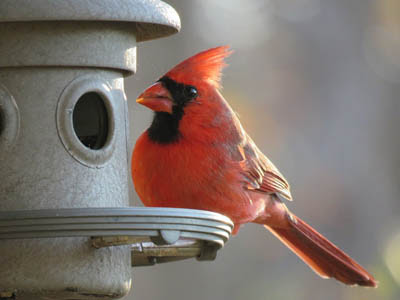 |
| Northern Cardinal. GeorgeB2 from Pixabay. |
Males of these large seed eaters are bright red with a black face and red crest.
Females replace most of the red with brown, The bill is large and orange.
These birds are found in woodlands, stream edges, residential areas.
Northern Cardinals are year-round residents throughout Virginia.
American Robin
These are familiar lawn birds with red breasts.
 |
| American Robin. Greg Gillson. |
Male American Robins are brownish-gray above with a brick red breast. Females are paler orange below and paler gray above.
They are widespread in open country with scattered deciduous trees, residential areas.
American Robins are year-round residents throughout Virginia.
House Finch
When people ask about a bird with a red head at their feeder, it is usually this bird.
 |
| Male House Finch. Greg Gillson. |
Males of this dusty brown striped finch have red limited to the head (specifically the forehead and eyebrow), breast (chest), and rump. The red coloration tends toward orangish, and may rarely be yellowish.
Females are streaked, similar to the males but without red. They lack any strong pattern on the face and head.
Note the small round head and curved upper ridge on the bill.
Some people call these red-headed sparrows. Sparrows and finches are similar, but in general, male finches are brighter than the females and tend to hang out more in trees. Sparrow genders are usually quite similar in coloration and tend to feed mostly on the ground.
These birds are common in residential areas, especially at bird feeders. In the West more widespread in arid regions near water.
House Finches are year-round residents throughout Virginia.
Ruby-throated Hummingbird
These red-throated birds are the only hummingbird nesting in the eastern United States.

Males are dark green above and on the belly. They have a white upper chest. The throat is ruby-red.
Females are green above, white below, including white throat.
These birds are found in woodland edges, residential yards. Readily come to hummingbird feeders.
Ruby-throated Hummingbirds are summer residents throughout Virginia.
Scarlet Tanager
A brilliant red and black bird!
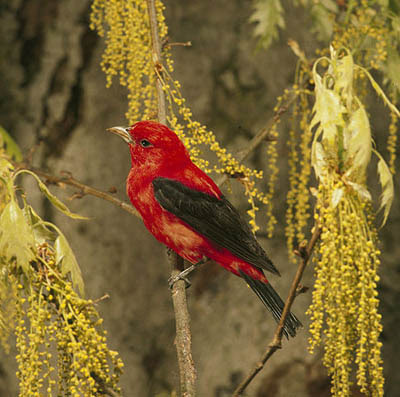 |
| Male Scarlet Tanager. USF&WS. Public Domain. |
Males are unmistakable with brilliant red with black wings and tail.
Females are olive-green above, darker wings and tail, yellower under parts. Pale bill.
These birds live in deciduous woods.
Scarlet Tanagers are summer residents throughout most of Virginia, spring and fall migrants only through southeastern Virginia.
Red-headed Woodpecker
These well-known woodpeckers with red heads have a fitting name.
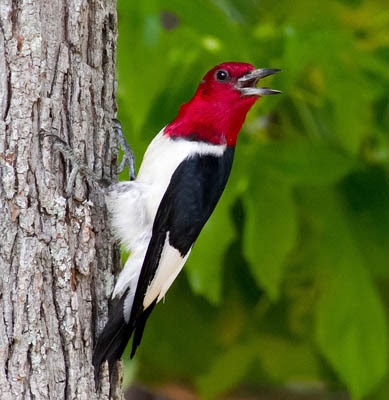 |
| Red-headed Woodpecker. Public domain. |
These birds have the entire head bright deep red. Back and tail black. Underparts white, as are inner secondaries and rump.
They are found in a variety of wooded habitats. They prefer to have oak and beech trees available. Sometimes come to feeders in winter.
Red-headed Woodpeckers are year-round residents throughout most of Virginia, absent in far western Virginia.
Summer Tanager
These bright red birds are found toward the tops of tall trees in the southern United States.

Males are rose red with fairly heavy bill.
Females are yellowish or mustard-colored, some with a faint reddish wash.
In the East these birds are found in pine-oak woodlands. In the West they prefer tall cottonwood trees.
Summer Tanagers are summer residents throughout Virginia.
Orange birds of Virginia
True orange-colored birds are not that common. Many birds that I have here are paler rusty.
The common pattern is an orange body and black or brown wings and tail. Another common pattern is for the orange to be restricted to the under parts.
The following are orange birds that you are most likely to see in Virginia.
Eastern Towhee
These birds with rusty-orange sides like to hide in dense bushes.
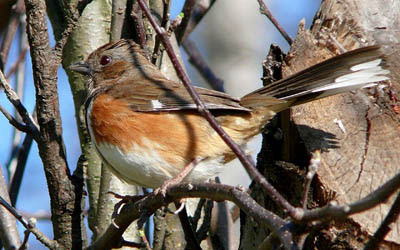 |
| Female Eastern Towhee. Skeeze. Pixabay. |
Males are black above with white wing patch, white tail corners. The sides are rusty. The belly white. Eyes variable: brown, red, orange, white, tending toward whiter southward.
Females are similar, but upper parts brown.
These birds are found in forest understory, dense brush, backyard hedges. Come to feeders.
Eastern Towhees are year-round residents throughout most of Virginia, summer residents only in northern Virginia.
Barn Swallow
These orange-bellied birds are a familiar sight across North America in summer.
 |
| Barn Swallow. Greg Gillson. |
These birds are purple-blue above with orange under parts and long forked tails. The color of the underparts in winter or on females are often cinnamon or buff-colored, but breeding males can be brighter orange-red.
These birds swoop low over fields and wetlands at lower elevations. They may build their mud nests in rafters on porches, garages, or other out-buildings.
Barn Swallows are summer residents throughout Virginia.
Brown Thrasher
These are rather large rusty-orange songbirds.
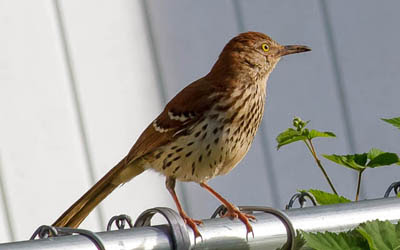 |
| Brown Thrasher. Linda Jones CC0. |
The upper parts of these birds is colored rusty-brown to orange. They show two white wing bars. Under parts are buff with heavy reddish-brown streaking.
These birds live in woodland edges and mature backyard landscaping.
Brown Thrashers are summer residents throughout Virginia, year-round residents in southern Virginia.
Red-shouldered Hawk
Okay, the shoulders are reddish. But the rusty-orange breast and wing linings are barred red too.
 |
| Red-shouldered Hawk. Greg Gillson. |
The upper parts are barred black and white. The tail is banded black and white. In adults the breast is barred orange.
Immature birds are streaked with brown on the breast.
These birds like woodland edges, residential edges, riparian groves.
Red-shouldered Hawks are year-round residents throughout Virginia.
Wood Thrush
These spotted birds with the orange-brown upper parts tend to hide in understory trees and on the forest floor.
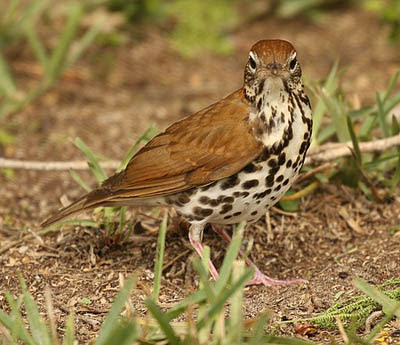 |
| Wood Thrush. Tony Castro. CC BY-SA 4.0 |
These birds are reddish brown on the upper parts, especially rusty orange on the crown and upper back. White eye ring. Large heavy black spots on the under parts.
They live in deciduous and mixed woods. Spend much time on the ground, shuffling through the leaf litter.
Wood Thrushes are summer residents throughout Virginia.
American Redstart
In flight these small warblers flash orange or yellow in the wing and base of the tail.
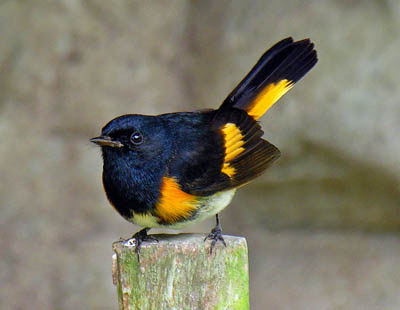 |
| American Redstart. Dennis Jarvis. Flikr. CC BY-SA 2.0 |
Males are black above, white on the belly. They have bright orange patches on side of breast, wings, and base of the tail.
Females are grayer, especially on the head. The orange of males is replaced by yellow on the females.
These birds are found in regenerating woods after a clear cut, and willow tangles along streams.
American Redstarts are summer residents throughout most of Virginia, spring and fall migrants only in southeastern Virginia.
Orchard Oriole
Males of these orioles are darker rustier-orange than most other orioles in the United States.
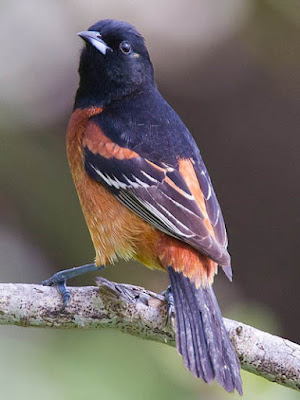 |
| Orchard Oriole. Dan Pancamo. Flikr. CC BY-SA 2.0 |
Males have a black hood and back, black wings and tail. The under parts are rusty-orange or even chestnut-brown.
Females are greenish above, lemon yellow below. They have 2 thin white wing bars. The bill is thinner than many other orioles.
They are found in orchards and residential shade trees.
Orchard Orioles are summer residents throughout Virginia.
American Kestrel
These are the familiar small rusty-orange falcons sitting on power lines on the edge of the highway, or hunting and hovering over the median strip.
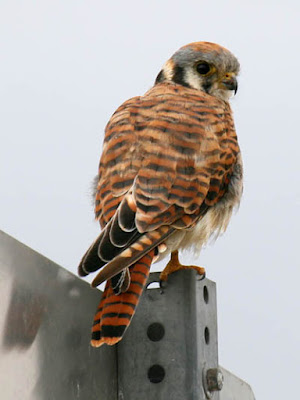 |
| Female American Kestrel. Greg Gillson. |
Females are rusty orange barred with black on their back wings and tail. The under parts are buff with black spots. The head shows two facial stripes.
Males have blue-gray backs and rufous tail is unmarked except for black tail band.
These birds are found in open country, farms, pastures with perches.
American Kestrels are year-round residents throughout Virginia.
Ruddy Duck
These small ducks are dark rusty-orange in spring.
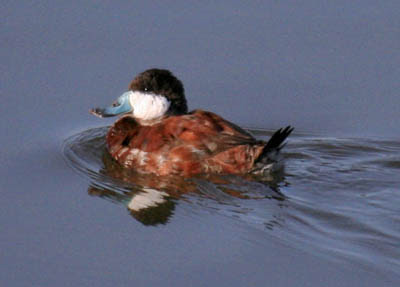 |
| Ruddy Duck. Greg Gillson. |
Males in breeding plumage (late winter and spring) are rusty, with a white face, and a blue bill. The long tail is often held sticking up. In winter they are brown, with white face, and dark bill.
Females all year are like winter males. Brown body, dark cap, dark line through eye of pale face. Dark bill.
These birds prefer weedy ponds to breed, but in winter may be found in deeper ponds in city parks.
Ruddy Ducks are winter visitors throughout Virginia.
Baltimore Oriole
These bright orange and black birds are fairly common breeders in wooded areas in the East.
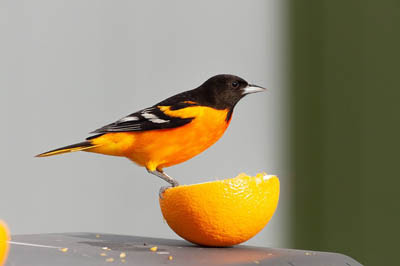 |
| Baltimore Oriole. Michael McGough. Pixabay. |
Males are have a black hood and back. Wings black with white patches. Tail black with orange sides to the base. Bright orange under parts.
Females are similar to males, but more olive above, less black. Immature birds for their first year or more are olive above orangish-yellow on the breast, fading to yellow on the belly. Two white wing bars.
These birds are common in deciduous woods, shade trees.
Baltimore Orioles are summer residents throughout most of Virginia, spring and fall migrants only in southeastern Virginia.
Red-breasted Nuthatch
These active little red-breasted birds crawls all around on the trunk and big branches of conifers. They search crevices in the bark for insect food.
 |
| Red-breasted Nuthatch. Greg Gillson. |
These tiny birds have blue-gray backs and a black line through a white face. Some males can have quite bright rusty red under parts. Some females can have quite pale buff-colored under parts. Most birds show an orange-cinnamon breast color.
Found nearly exclusively in conifers. Readily come to feeders.
Red-breasted Nuthatches are winter visitors throughout Virginia, year-round residents along the northwestern border of Virginia.
Yellow birds of Virginia
Yellow is a common bird color! Often it is mixed with black and white plumage in birds.
Many birds with darker upper parts have yellow breast or belly.
The following are yellow birds you are most likely to see in Virginia.
American Goldfinch
These small little birds are bright yellow and black.
 |
| American Goldfinch. Greg Gillson. |
Males are bright lemon yellow with black and white wings and tail, black cap. White under tail coverts. Pink bill.
Females are duller yellow below and brownish above. Lack black cap.
Winter birds are pale brown or gray, a touch of yellow on the throat of males.
These are birds of open country, fields with saplings, clear cuts, residential areas. They avoid dense forests, mountains, deserts. They visit feeders.
American Goldfinches are year-round residents throughout Virginia.
Northern Flicker
These woodpeckers spend much time eating ants on the ground.
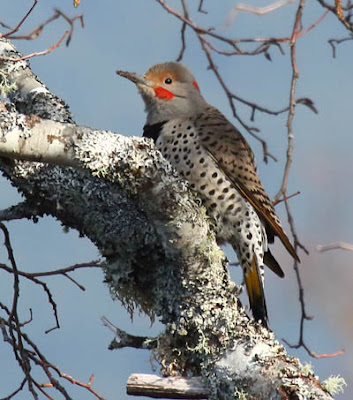 |
| Northern Flicker. Greg Gillson. |
These birds are larger than robins with brown and black barred upper parts. The underparts are pink with round black spots. There is a black crescent across the chest. When they fly away from you they reveal a large white rump.
Western birds have salmon-red under wings and under tail. Those in the East are colored yellow. The male face differs between the two populations–black whisker on the eastern birds, red whisker on western birds. Intergrades from overlap on Great Plains common. These may show male facial characteristics of both populations, or yellow-orange flight feathers.
These birds live in open woods with bare ground for foraging, residential yards.
Northern Flickers year-round residents throughout Virginia.
Yellow-rumped Warbler
These are abundant warblers across North America. Affectionately called “butter butts” by many birders, because of their bright yellow rumps that flash in flight.
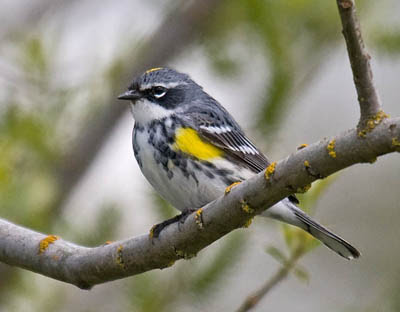 |
| Breeding Yellow-rumped (Myrtle) Warbler. Greg Gillson. |
Western form (Audubon’s) with bright yellow throat and yellow rump. Large white wing patch.
Northern and Eastern form (Myrtle) with white throat, yellow rump, and two white wing bars.
Winter birds are dull gray brown, with bright yellow rump. Throat may be cream colored or white. Often difficult to tell the two forms apart in winter.
 |
| Winter Yellow-rumped Warbler. Greg Gillson. |
Breed in mountain or boreal conifers. Widespread in migration. Winter in low river bottoms, open weedy deciduous areas. Rarely come to feeders in winter.
Yellow-rumped Warblers are winter visitors throughout most of Virginia, spring and fall migrants only in the mountains of western Virginia.
Common Yellowthroat
These buttery yellow birds are abundant in the marsh vegetation.
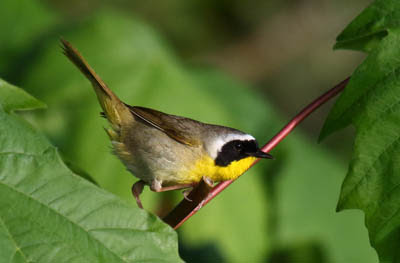 |
| Male Common Yellowthroat. Greg Gillson. |
These skulkers have bright yellow throats and yellow undertail coverts. Males have a black domino mask edged broadly in white, which females lack. Upperparts are dull olive-green.
Immature males in fall show a shadowed black mask.
Found in damp situations and heavy deciduous brambles following clear cuts.
Common Yellowthroats are summer residents throughout Virginia, year-round residents in eastern Virginia.
Cedar Waxwing
These crested birds with yellow band on the end of the tail are often found in flocks. They eat flying insects in summer, fruit and berries the rest of the year.
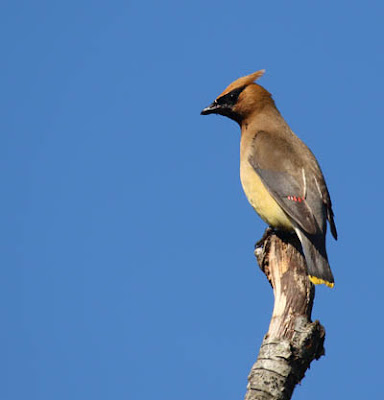 |
| Cedar Waxwing. Greg Gillson. |
These birds are fawn-brown above, with dark gray wings and tail. They have a black mask and wispy crest. The belly is yellow. The wings have waxy red drops on the end of the tertials. The end of the tail has a brilliant yellow tail band.
They are found in open habitats with berries, including juniper woodlands and towns in winter.
Cedar Waxwings are year-round residents throughout Virginia.
Great Crested Flycatcher
These flycatchers have long tails and big heads with big bill and bright yellow belly.
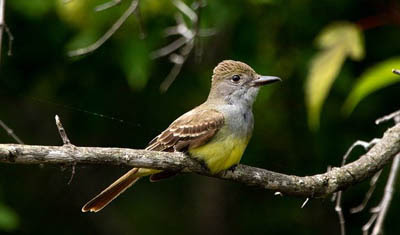 |
| Great Crested Flycatcher. Simard Francois. Pixabay. |
These birds are gray on the face and breast, brownish on rest of upper parts. Bright lemon yellow belly. The under side of the tail and some feathers of the wing are cinnamon colored.
These birds stay in the canopy of open woods.
Great Crested Flycatchers are summer residents throughout Virginia.
Pine Warbler
This yellow and gray bird is one of the few warblers to visit feeders–and the only one to eat seeds!
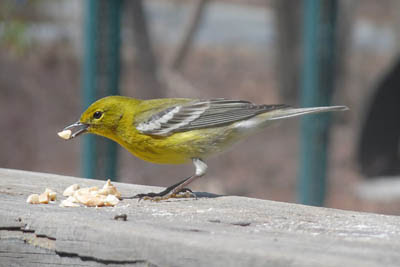 |
| Pine Warbler. Nikolaus Schultz. Pixabay. |
These birds are yellow-green on head, back, and breast. Wings blue-gray with wide white wing bars. Yellow split eye ring.
Strongly associated with pine forests. Usually high in tree tops.
Pine Warblers are summer residents throughout Virginia, year-round residents in southeastern Virginia.
Eastern Meadowlark
These pale brown birds with the brilliant yellow breasts are home on the ground in prairies. They sing from perches on isolated trees, power poles, fence posts.
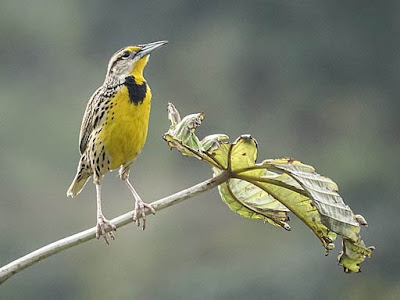 |
|
Eastern Meadowlark
Photo by Mike’s Birds from Riverside, CA, US [CC BY-SA 2.0]
|
The upper parts are streaked black, white, brown, so they blend into the dried grass where they live. The under parts are bright yellow with a black necklace across the chest. Very similar to Western Meadowlark, best told apart by spring song.
These birds live in prairies and extensive pasture lands.
Eastern Meadowlarks are year-round residents throughout Virginia.
Northern Parula
This is a handsome blue and yellow warbler.

Males are blue on the hood and shoulders. Back green. Yellow throat and breast with a dark red spot mid-chest. Broken white eye ring. Two wide white wing bars.
Females are similar, but paler.
They are found along streams and in swampy forests with willows, maples, birches, hemlocks and other trees.
Northern Parulas are summer residents throughout Virginia.
Yellow-breasted Chat
These unique larger yellow birds may sing day and night, and include whistles and crow-like cawing, often given in a display flight.
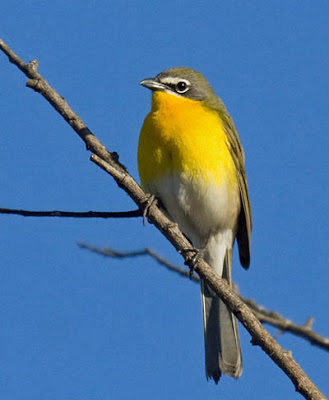 |
| Yellow-breasted Chat. Greg Gillson. |
These birds are greenish above with bright yellow breast and white belly. They have a dark mask bordered with white.
These birds live in tangles and wet woods.
Yellow-breasted Chats are summer residents throughout Virginia.
Yellow-throated Vireo
Vireos are slow moving small birds that sing throughout the day. These yellow-headed vireos are one of the most colorful of their clan.
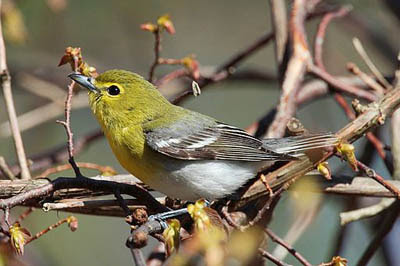 |
| Yellow-throated Vireo. MDF. CC BY-SA 3.0 |
These birds are blue-gray above, white below. Two white wing bars. Their head is olive yellow with yellow spectacles around the eye, and bright yellow throat.
These birds like large tracts of unbroken deciduous or mixed woodlands. Interestingly, however, they are often found on forest edges.
Yellow-throated Vireos are summer residents throughout Virginia.
Wrapping Up
Birds have brilliantly colored plumage for a range of reasons and they get those colors in different ways. From the fiery red of a cardinal to the iridescent blue of an indigo bunting, this vibrant palette is thanks to two main factors: pigments and structure.
Melanin: This pigment produces shades of black, brown, and gray. Found in feathers, skin, and beak, melanin is responsible for the common earth tones seen in many birds.
Carotenoids: These pigments are derived from food (plants, insects) and are responsible for yellows, oranges, and reds. Birds can’t produce carotenoids themselves, so they rely on their diet to acquire these vibrant colors.
Feather structure: The microscopic arrangement of feather barbules and barbells can reflect, refract, and scatter light, creating iridescent blues, greens, and violets. This structural effect, independent of pigments, adds another layer of complexity to bird plumage.
Here’s how these factors work together:
Melanin and carotenoids in feathers: Depending on the concentration and combination of these pigments, different colors emerge. For example, a high concentration of melanin combined with some carotenoids will produce brown; less melanin and more carotenoids can result in red or orange.
Structural colors: These iridescent hues arise from the intricate architecture of feathers, often in combination with pigments. Light interacts with the microscopic layers and air spaces within feathers, creating vibrant blues, greens, and violets without any pigments present.
Who knew it was all so complicated!
Frequently Asked Questions
What Virginia bird is red with black wings?
Scarlet Tanagers are vibrant summer visitors to Virginia, gracing its forests with their fiery red plumage. Finding them requires knowing their preferred habitats and timing your exploration right. Here’s where you can potentially encounter these breathtaking birds:
Habitat:
Deciduous forests: Scarlet Tanagers favor mature deciduous forests, particularly with oak and hickory trees. Look for areas with tall trees, open canopy, and diverse undergrowth.
Woodland edges: They often frequent edges of forests, where sunlight penetrates and creates a richer food source.
Parks and backyards: While less common, Scarlet Tanagers can occasionally visit parklands and large backyards with mature trees, especially if they offer suitable nesting sites.
Timing:
Migration: Arrive in Virginia around late April to early May and stay until late August to early September. Focus your search during these months for the best chance of encountering them.
Time of day: They are most active at dawn and dusk when they sing most often, making these times ideal for spotting them.
Specific locations:
Shenandoah National Park: With its vast deciduous forests, particularly those dominated by oaks, Shenandoah National Park offers excellent opportunities to find Scarlet Tanagers. Areas like Big Meadows, Lewis Mountain Trail, and Skyline Drive are promising spots.
Great Dismal Swamp National Wildlife Refuge: This wetland refuge provides nesting habitat for Scarlet Tanagers along its wooded edges and mature cypress trees.
Blue Ridge Parkway: The parkway traverses various wooded areas suitable for Scarlet Tanagers. Stop at overlooks and hike shorter trails in wooded areas for potential sightings.
Back Bay National Wildlife Refuge: The wooded edges of freshwater ponds and marshes within the refuge can attract these tanagers.
What is the orange beaked bird in Virginia?
Determining the orange-beaked bird in Virginia requires some additional information as several feathered friends in the state sport this vibrant accessory. To help narrow it down, consider these factors:
Time of year:
- Summer:
- American Robin: They have an orange-yellow beak and a dark gray back with a reddish breast.
- Baltimore Oriole: Males showcase an orange body with black wings and head, and an orange-red beak. Females display a yellow chest and olive back with an orange-brown beak.
- Scarlet Tanager: Males boast fiery red plumage with black wings and head, and a dark orange beak. Females are greenish with red streaks and a dull orange beak.
- Winter:
- Common Redpoll: Males have a small red patch on their breast and a dark orange-brown beak. Females lack the red but might show pale streaking and a light orange beak.
- Pine Grosbeak: Very rare winter visitors, males are rose-red with a thick orange beak. Females are brown with pinkish tinges and a paler orange beak.
What is the gray bird in Virginia with yellow belly?
This is actually the Virginia’s Warbler and it is not actually native to Virginia, despite its misleading name. Here’s why:
- Origin: This small warbler species primarily inhabits the pinyon-pine and oak woodlands of the southwestern United States, with its range extending from southern Colorado and Wyoming to central New Mexico and Arizona. The closest it gets to Virginia is the eastern edge of Texas.
- Naming history: The Virginia Warbler was named in 1858 by John Cassin, an American ornithologist, after Virginia Anderson, the wife of an army surgeon stationed at Fort Burgwin in New Mexico. This was likely due to an early misidentification and confusion with another bird species.
Thus, the Virginia Warbler’s name holds more historical significance than geographical accuracy. Although not found in Virginia, it plays a vital role in the ecosystems of its natural southwestern range, adding vibrant splashes of color and melodious songs to the arid landscapes.
Related Articles:
See photos and learn about the most common backyard birds in Virginia, regardless of color.
See photos and learn what to feed winter birds in Virginia.
Here’s a quick tutorial of how I would teach you to identify birds: 7 Steps to Identify Birds!
Birds with red heads in North America.










